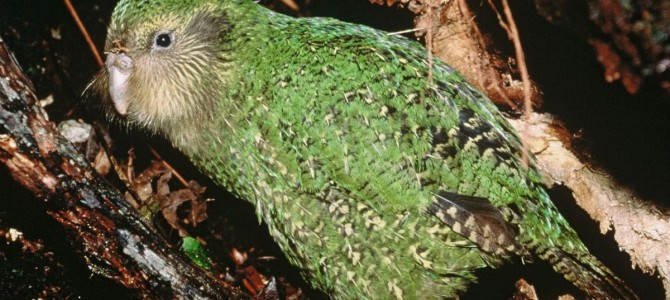
Deep in the lush green undergrowth of the primeval forests of New Zealand lives a curious creature. No, not Peter Jackson. A Kakapo.
The Kakapo is the world’s only flightless parrot. At an impressive average of 25 inches high and 4.5 pounds, it’s also the world’s largest parrot. As an added bonus, the flightless fowl has a noticeably nice smell, presumably to attract mates—although as we will see later on, this hasn’t worked out so well for the Kakapo.
This charming little creature, like its Kiwi relative, is primarily nocturnal. Slumbering among the lower branches of the forest foliage during the daylight hours, the Kakapo begins its business when the sun goes down. The bird’s inclination for the nightlife is also where it gets its Maori name (Maori is the language of the indigenous people of New Zealand), “kaka,” meaning parrot, and “po” meaning night.
Our feathered friend is also known by another name, its generic name, Strigops, which is Greek for “owl face.” I’d like to take just a moment to have tiny tirade about the name “owl face.” While the bird does bear some resemblance to an owl, in that it has a face and so do owls, could the British ornithologist George Robert Gray, who first described the flightless fowl in 1845, really do no better than “owl face”?
You’ll Never Believe How It ‘Defends’ Itself
As the brilliant colors of the last light of day fade while the sun sinks slowly into the ocean’s horizon, this portly parrot awakens and begins its daily forage for food. Unfortunately for the Kakapo, its favorite food is the fruit of the rimu tree, which grows 90 feet off the forest floor. Although not an ideal adaptation by any measure, this sweet little abomination has developed an enthusiastic ability to climb up ridiculously tall trees using its beak and two strong legs, laboriously inching up the trunk of the rimu tree until at last, the herculean effort has paid off and Kakapo can claim its delicious prize.
Getting down from the tree is much easier. For a bird with wings it doesn’t use for flying, it has improvised remarkably well, jumping off the top of the tree and using its perfectly good wings to “parachute” down, almost in a glide, as it lights on the forest floor in what to my mind must look like a controlled plummet. This curious adaptation must work, or surely we’d have heard about the great plummeting parrots of New Zealand.
Probably the most surprising part of the Kakapo’s story is that it still exists at all. The Kakapo’s evolution is a cautionary tale, and one that the modern dating world would do well to hear. You see, the Kakapo is not just a giant parrot with pitiable flying skills that smells nice. It’s also a giant wuss.
Indulge me for a moment while I explain. Among the more unfortunate characteristics of the Kakapo is its defense mechanism. When threatened, the Kakapo stands perfectly still, like a statue. This disastrous defensive posture makes the poor creature an incredibly easy target for predators, and might just make the masculine members of the Kakapo the first known animal species to consist entirely of beta males. If you’re unfamiliar with the term, Urban Dictionary has a fairly accurate definition here.
Scientists posit the reason the Kakapo go statuesque when startled is due the fact that, until explorers introduced predation like cats and rats to New Zealand, these earthbound birds were very good at hiding from the precious few predators they ever encountered.
If You Thought the Defensive Strategy Was Bad, Just Look at the Offense
Perhaps I’m being a little unfair to the poor Kakapo. After all, it did manage to survive just fine for however many thousands of years by hiding like a coward under a fallen tree, or rock. That would be a fine argument to make but for the fact that they don’t hide any more. They freeze in place, and this utter failure of self-preservation is part of a larger issue that has put the Kakapo on the critically endangered list, a status for which the beta-male attributes of the male Kakapo are largely to blame.
You see the Kakapo mating ritual has become so embarrassingly ineffective that they hardly ever reproduce. It’s just crap. When the male Kakapo is ready to mate, he sits on the forest floor and lets out a low foghorn-like moan that can be heard from three miles away, alerting females in the area. So any girl within three miles, unless she’s deaf, knows this Kakapo is ready for love, and it goes on like this for three months.
Except that, on most nights, females don’t answer the call. It’s not that they aren’t that into him, they’re just not that into mating, period. While the male Kakapo’s reproductive urges last about three months out of the year, the female’s romantic interest peaks about once every five years.
This species is a perfect example of what happens in a society with no alpha males. After decades of beta-male domination, men will be sitting passively in their trendy restaurants, drinking their Sidecars, trying to hook-up on Tinder, while all the females within four blocks of them swipe left.
Fat, Flightless, and Celibate Is No Way to Live
Kakapos, and every society really, need alpha males. An alpha male doesn’t sit passively by hoping a woman will fall out of tree and come find him; he goes out and actively pursues her. (Disclaimer, I am not in any way advocating stalking or violence towards either women or female Kakapos.) Alpha males also create vitally important competition within the species. They will compete for their mate, guaranteeing that females are getting the best of the species. They don’t sit on the ground moaning like a foghorn while being ignored for five years.
That’s because fat, flightless, and celibate is no way to go through life. The active role an alpha male takes in his community ensures the survival of his species. The Kakapo numbers would be higher if more Kakapo babies were being born and the Kakapo stopped standing still for predators. Alpha males make babies, and they don’t stand idly by while a predator eats them. They defend themselves, and their families. The Kakapos don’t even hide under rocks anymore. They just freeze. No wonder females would rather sleep than mate. Weakness is unattractive in any species.
I’ve had great deal of fun at the Kakapos’ expense, but there really is a more pressing issue at stake. Support for the beta-male population is growing. Pajama boys everywhere are leaving the safety of their apartments and T-shirt collections, and becoming more mainstream.
This trend does not bode well for the future of humanity. With birthrates already declining, if, heaven forbid, the alpha-male numbers sink any lower, we risk ending up with a civilization of male Kakapos: trendy passive males who smell nice but can’t land a punch, sitting in their safe spaces trying to get with a population of apathetic females who are completely uninterested in a relationship, never mind having babies with them.
A society of alpha males, and a girl is spoiled for choice; a society of beta males, and a girl would rather sleep than try to get with a guy she’d have to defend in a street fight.









